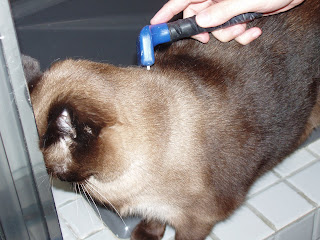
 A few weeks ago, we went to a local auction house. We coveted this pretty pair of Arts and Crafts candlesticks. We had agreed on an upper limit of $200, so we stopped bidding when it reached that price. The other buyer got them for....$200. Which is probably just as well. Who knows how high they would have been willing to go? Plus, we have too much stuff as it is. But they sure would have looked nice on our dining table.
A few weeks ago, we went to a local auction house. We coveted this pretty pair of Arts and Crafts candlesticks. We had agreed on an upper limit of $200, so we stopped bidding when it reached that price. The other buyer got them for....$200. Which is probably just as well. Who knows how high they would have been willing to go? Plus, we have too much stuff as it is. But they sure would have looked nice on our dining table.Theyalso had a lot of books, including a bunch on Frank Lloyd Wright. We (especially Frink) have lusted after the the collectible Selected Drawings Portfolio, issued in 3 volumes in a limited edition of 700 copies by Horizon Press. These are huge 17 x 21 books with loose leaf, colored reproductions of the presentation drawings Wright gave to prospective clients. Some are for buildings that were never realized. The books are listed online for $1500 or more apiece. The auction house estimate was $600-800. Even that was way more than we could afford. But after losing the candlesticks, we stuck around to see what would happen.
We bid on several other FLW books, usually competing with the same two buyers. One guy, a stocky, long-haired fellow in a white t-shirt, was very determined. We were sitting in the back of the room, he was in front. When the FLW books came up, he just held his paddle steadily aloft, not raising and lowering it like everyone else, not looking around to see who else was bidding. If this was meant to intimidate, it did. We had set our upper limit on everything, generally $60, and when the bids reached that poi
 nt, we stopped. (Thanks to Frink: I tend to get overly competitive and excited in auction situations, but Frink has a very steady and cautious approach.) So, White Shirt Guy got several lots of books for $60. We did win one book that sells online for $150-200 (a steal at $50.)
nt, we stopped. (Thanks to Frink: I tend to get overly competitive and excited in auction situations, but Frink has a very steady and cautious approach.) So, White Shirt Guy got several lots of books for $60. We did win one book that sells online for $150-200 (a steal at $50.)Then the 3 volumes of portfolios came up. Now, we had no delusions that we would be able to afford one, but had discussed what our upper limit would be if, by a fluke, they went for less than the estimate. We settled on $300. In the pitch of excitement and confusion, we dropped out and the first volume went for $275 to White Shirt Guy. Then volume two came up, and we bid. Amazingly, we got it for under $275!! Volume 3, which is usually the most expensive of the three, went to the other person who was bidding for the great price of $400. But we left very happy. And determined not to eat out or otherwise spend money for the next couple of months.
 Read more!
Read more!







































